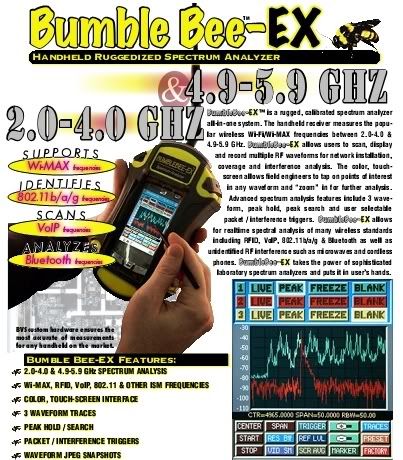rubes72 said:
Hey Jarance, what do you think of Infra-Red scanners? I know they can penetrate metal. Just thot I asked, I think you're a techie, from the arguments you made.
Did the test you recommended, You were right lots of noise ... most noise from flourecent lights... but when you point it directly into your lap top... wow you get a different reading for each chip used. With Wifi turned on you get a spike of -40Db. When notebook closed you do not get any spike. However when scanned a battery, connected to the notebook got -78Db. Equipment used, RAYCOM scope with open flange concentrator antennae, and amplified using a low noise apmlifier 8hz to 16Ghz. what I was scanning was electrical interference.
From Wikipedia, the free encyclopedia
Electromagnetic radiation is generally described as a self-propagating wave in space with electric and magnetic components. These components oscillate at right angles to each other and to the direction of propagation, and are in phase with each other. Electromagnetic radiation is classified into types according to the frequency of the wave: these types include, in order of increasing frequency, radio waves, microwaves, terahertz radiation, infrared radiation, visible light, ultraviolet radiation, X-rays and gamma rays.
Based on the aboves, all sounds, light and radio waves fall under the same family. However, due to the large span of the wavelength spectrum, various unit are use to measure the amplitude or range.
In the case of human, most of us can see the colour or light from 380 to 700 micrometer. Majority of the human can hear sound from 20 Hz to 20 KHz but we are most sensitive to sound in the range of 1000 to 3500 Hz. That is why we cannot "hear" a dog whistle but the dog can hear it. As the frequency get higher, they go into the Ultrasound from 2 MHz to 200 MHz. (Hz = Hertz). This is the sound wave where is it use to transmit or broadcast our TV and radio channel. Low frequency like sound are modulate with ultrasound which act like carrier. Your TV received this high frequency and demodulate it to audible sound.
Ultrasound have been widely used in industry. You have ultrasonic cleaner, ultrasonic scanner (scan an unborn baby in the hospital). We also use X-Ray which falls into a different wavelenght all together.
Another wavelength is the UV (Ultraviolet) and IR (Infrared) which fall outside the range of human sight.
UV are basically short wavelength and high frequency. They fall in the range of 400 to 200 nanometer. UV is invisible to human eye but harmful to human skin. You get sun burn is not because you are exposed to the sun but to UV light radiated from the sun.
IR are long wavelength and low frequency waveform. They fall in the range of 750 nanometer to 1 mm. Some of light are visible to the human eye but some of not. Eg. Light emitting diode (LED) are visible to human eye. However, in most modern remote control for TV and Handphone, the IR are not visible to eye. Depending on the wavelength, some remote control required a "Line of sight" in order to work properly but some do not. The IR can bounce off the wall to the IR receiver.
Hence, to answer your question whether IR can penetrate metal, you can conduct a simple experiment with your remote control. Point your TV remote control and change a channel. Put a piece of paper/tin box in front of the remote control and try to change the channel. let me know the result.


